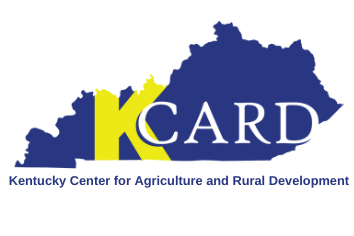Launched in 2020, KCARD’s Kentucky Local Food Expansion Initiative connects local farmers to buyers and seeks to grow a strong and diverse buyer-producer network across the state. One aspect of the initiative includes visualizing where local food production and sales are already occurring and where they are not to inform the work.
In a collaboration with the University of Kentucky’s Center for Crop Diversification and the Kentucky Horticulture Council, KCARD used data from the USDA 2017 Census of Agriculture to create a series of maps that provide a county-by-county look at the sales of certain local agricultural goods and the value of market channels through which these food crops and products are sold.
Available through the Center for Crop Diversification website, anyone can explore these local food census maps. These maps help visualize the number of farms across Kentucky that are involved in food production, such as fruit and berry farms and vegetable farms, along with the value of food sold direct to consumers or sold to retail markets, institutions, and food hubs. Ag Census data on this topic may not be a complete representation of local sales given that many local sales may be underreported, but the maps can still help in comparing the value of channels in different regions.
The value of local marketing channels
An important marketing strategy for many local food producers is direct-to-consumer sales. A map of the value of these sales in 2017 shows that 32 counties reported $250,000 or more in direct-to-consumer sales, while over half of those counties reported $500,000 or more in sales. A comparison of direct-to-consumer sales data from 2012 and 2017 reveals that the number of counties recording over $500,000 in direct food sales tripled, from 5 counties in 2012, to 16 counties in 2017. State-wide, direct sales increased from 15.8 million dollars to 26.6 million dollars over those five years, a 68 percent increase.
The initiative aims to expand local food markets beyond direct-to-consumer outlets to include institutions, retail markets, and food hubs. This map reveals that these markets do not make up a large share of local food sales in most counties. Only seven counties generate $500,000 or more through these distribution channels.
Future mapping projects
By developing maps of local agriculture sales, KCARD and partner organizations can focus attention and resources on areas that could benefit from improved connections between buyers and local farmers, as well as on areas that have the potential to continue growing existing local food networks.
One of the goals of the Kentucky Local Food Expansion Initiative is to increase the likelihood of sustaining local food business success by developing maps of distribution channels, clusters of local food economic growth, and local value chains. These maps are currently in development. Beyond the life of the initiative, these maps will help inform partners, stakeholders, farmers and buyers as they continue to access and expand Kentucky’s local food markets.
For inquiries regarding the local food census maps or KCARD’s Kentucky Local Food Expansion Initiative, please contact Olivia Vogel at ovogel@kcard.info or (859) 813-0658.

